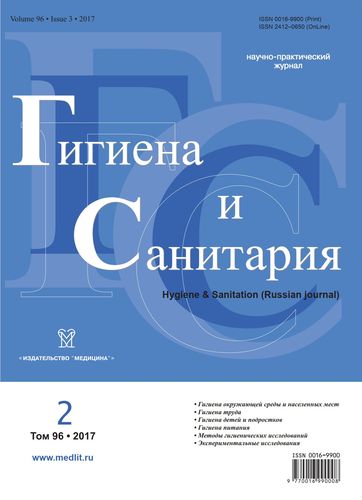Distribution of bacterial spores in supermarkets
- Authors: Tets V.V.1, Tets G.V.1, Kardava K.M.1
-
Affiliations:
- First I.P. Pavlov State Medical University
- Issue: Vol 96, No 2 (2017)
- Pages: 124-127
- Section: ENVIRONMENTAL HYGIENE
- Published: 21.10.2020
- URL: https://ruspoj.com/0016-9900/article/view/640610
- DOI: https://doi.org/10.1882/0016-9900-2017-96-2-124-127
- ID: 640610
Cite item
Full Text
Abstract
This work presents results of the study on the environment prevalence of spores of aerobic bacteria, which are of potential danger to human health. The investigation of swabs from handles of supermarket trolleys revealed on their surface the presence of a large number of spores of unrelated pathogenic bacteria carrying as antibiotic resistance genes and the origin of genes protected by bacterial spores from harmful environmental conditions as well. The high resistance of bacterial spores to antiseptics and disinfectants can be considered as the reason for the their accumulation in the environment.
About the authors
Victor V. Tets
First I.P. Pavlov State Medical University
Author for correspondence.
Email: vtetzv@yahoo.com
Russian Federation
G. V. Tets
First I.P. Pavlov State Medical University
Email: noemail@neicon.ru
Russian Federation
K. M. Kardava
First I.P. Pavlov State Medical University
Email: noemail@neicon.ru
Russian Federation
References
- Weber D.J., Rutala W.A., Sickbert-Bennet E.E. Outbreaks associated with contaminated Antiseptics and Disinfectants. Antimicrob. Agents Chemother. 2007; 51(12): 4217-24.
- Тец Г.В., Тец В.В., Артеменко Н.К. Спорообразующие бактерии - возбудители заболеваний дыхательной системы и предотвращение их распространения в стационаре. Практическая пульмонология. 2015; (1): 43-5.
- Moeller R., Raguse M., Reitz G., Okayasu R., Li Z., Klein S. et al. Resistance of Bacillus subtilis spore DNA to lethal ionizing radiation damage relies primarily on spore core components and DNA repair, with minor effects of oxygen radical detoxification. Appl. Environ. Microbiol. 2014; 80(1): 104-9.
- The Global Biodiversity Information Facility (GBIF). Available at http://www.gbif.org/species/8113
- Schmidt T.R., Scott E.J. 2nd, Dyer D.W. Whole-genome phylogenies of the family Bacillaceae and expansion of the sigma factor gene family in the Bacillus cereus species-group. BMC Genomics. 2011; 12: 430.
- Tetz G.V., Tetz V.V. Complete Genome Sequence of Bacilli bacterium Strain VT-13-104 Isolated from the Intestine of a Patient with Duodenal Cancer. Genome Announc. 2015; 3(4): e00705-15.
- Tetz G.V., Tetz V.V., Vecherkovskaya M.F. Complete Genome Sequence of Paenibacillus sp. Strain VT 400, Isolated from the Saliva of a Child with Acute Lymphoblastic Leukemia. Genome Announc. 2015; 3(4): e00894-15.
- Тец В.В., Тец Г.В., Викина Д.С., Вечерковская М.Ф., Харламова В.В. Неизвестные возбудители заболеваний в микрофлоре ротовой полости человека, актуальные для оториноларингологии. Вестник оториноларингологии. 2014; (1): 33-6.
- McDonnell G., Russell D.A. Antiseptics and Disinfectants: Activity, Action, and Resistance. Clin. Microbiol. Rev. 1999; 12(1): 147-79.
- Setlow P. I will survive: DNA protection in bacterial spores. Trends Microbiol. 2007; 15(4): 172-80.
- Thomas P., Aswath C. Alcohol-Mediated Horizontal Spread of Bacillus Spores and Assessing the Recurrent Sterilization Needs of Culture-Handling Tools Contaminated with Hardy Spores. C. Proc. Natl. Acad. Sci., India, Sect. B Biol. Sci. 2013; 83(2): 207-13.
- Brossier F., Mock M. Toxins of Bacillus anthracis. Toxicon. 2001; 39(11): 1747-55.
- Steen M.K., Bruno-Murtha L.A., Chaux G., Lazar H., Bernard S., Sulis C. Bacillus cereus endocarditis: report of a case and review. Clin. Infect. Dis. 1992; 14(4): 945-6.
- Drobniewski F.A. Bacillus cereus and related species. Clin.Microbiol. Rev. 1993; 6(4): 324-38.
Supplementary files









